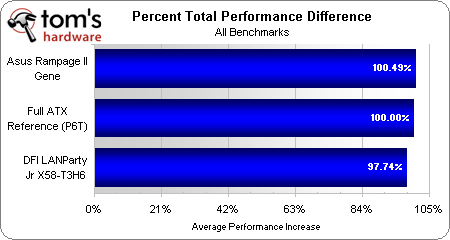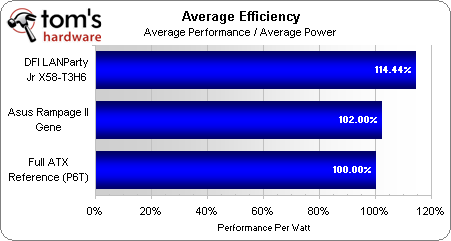Asus And DFI: Core i7 Micro-ATX Motherboards Compared
Conclusion
Top-quality Micro-ATX motherboards offer a level of performance, stability, and capability believed by many to be possible only with full-sized parts. The results make sense because of the equally-sized upper portion of Micro-ATX and full ATX motherboards, but this is the first time we’ve seen manufacturers put serious effort into the overclocking capabilities of the four-slot form factor. For those of you who’ve jumped ahead, the DFI LANParty Jr X58-T3H6 and Asus Rampage II Gene actually exceeded the overclocking capability of the full-sized Asus P6T on this article’s previous page.
But some readers are only interested in benchmarks, so here’s a quick recap of how each Micro-ATX motherboard performed against the full ATX Asus P6T.
The LANParty Jr X58-T3H6 lagged slightly behind the full-sized-class-leading P6T, but a look back at our earlier comparison reveals that performance levels for DFI’s ATX and Micro-ATX motherboards are almost identical. The real star of today’s performance shootout was the Rampage II Gene, with prowess to outclass even the best board of that previous comparison.
We’re sure that several readers will point out that Asus has an advantage due to running its default base clock at 0.20% over reference speed, but its performance lead is much greater than 0.20%. We even monitored Bclk through several benchmarks to make sure Asus wasn’t ramping up base clock in some other way. Instead it appears that Asus has figured out a way to better-manage Intel’s Turbo mode, while also finessing voltage levels to keep everything stable. But Asus’ added performance came at a sizeable power-consumption cost. Dividing the relative performance of each motherboard (from the chart above) by the average of its full load and idle power consumption (previous page) shows a stark contrast in efficiency.
Though it did beat even our fastest full-ATX P6T motherboard in both performance and efficiency, the Rampage II Gene’s improved efficiency wasn't able to best that of DFI’s LANParty Jr X58-T3H6.
Great results from both Micro-ATX motherboards prove that the only significant reason to “go big” is to get a couple extra slots. But most builders never use more than four slots, even in an SLI gaming configuration. Anyone who truly desires a smaller-format high-end PC can no longer use the motherboard as their excuse for not chasing their dream.
Get Tom's Hardware's best news and in-depth reviews, straight to your inbox.
-
IzzyCraft Shame the DFI board didn't do better it help shut up people going where is the Rampage II gene in the Builders marathon.Reply
Although this review let me have a little more respect for the board I'm still asus and gigabyte all the way. -
Proximon Really nice article! BIOS screenshots are so important when helping someone configure their board on line, and we do a lot of that around here. I thought you hit all the major points and I especially like the conclusion format.Reply -
andy_mcp1 Great article. About time the facts were laid on the table. I've not quite got to upgrading to I7 M-Atx yet, but got an Asus P5E-VM (not the best admittedly) and an E8400 which on air is oc'd to 4.1Ghz stable (for the past 8 months), which I’ve on countless occasions used to show my mates who have full atx systems that bigger isn’t always better as my 3dmark and pcmark scores were better than theirs (of comparable full sized board builds).Reply
Good point, and I agree, that the hardest thing for the market is for those who have idealisms that the atx board with the most slots are best, have to admit that this not the case, that they don’t need and wont likely use them. It’s about time technology moved on and we start shrinking the components. We've come a long way from house sized computers but seems to have got stuck with fridge-sized atx, time to change that and join the 21st century! -
doomtomb The prices between the DFI and Asus are nearly the same, a difference of $20 or $30. The Asus Rampage II Gene wins it in my opinion.Reply -
SpadeM For me, it's about the features and backplate I/O ports not the performance, when it comes to motherboards with the same chipset. The differences between them is so little that it doesn't matter in real life. Plus given the fat that motherboards, like processors, aren't identical I might get one that performs lower/better then what's in this review.Reply -
Crashman IzzyCraftShame the DFI board didn't do better it help shut up people going where is the Rampage II gene in the Builders marathon.Although this review let me have a little more respect for the board I'm still asus and gigabyte all the way.Reply
Really, the reason the Rampage II Gene wasn't considered for the $2500 PC is that it didn't show up under a Newegg category search (LGA-1366, Micro ATX) and Newegg didn't fix that until this week. It's a good board, and if you need a weird cooler style, supports the more popular LGA-775 coolers. -
atamanroman I like it that uatx is getting more and more attention, since my own i7 uatx cube project is only a few weeks away.Reply
but im missing the MSI X58M (160€ best prive vs 198€ asus and 190 dfi) here, theres a great review at anandtech. the board really rocks and has only a few weak points (fan control and s3 wake up problem if overclocked). i think ppl would be glad if the msi could be added to this comparison.
best regards,
roman -
zehpavora Very good article, but I think that the components chosen should be from the same time frame, because I think that the P6T is "too old" compared to the GENE board. Maybe the P6T V2 would be a better idea. Now I fear the Mini-ATXs.Reply -
avatar_raq Nice article..I wonder if you were planning on it for a while or you wrote it in response to our comments in the SBM..And yeah it showed what I always expect from ASUS; top notch mobos.Reply
P eople go for a full atx build simply because they can (:P), and because larger cases offer better cooling especially for SLI and CF, it's much easier to build and, other than portability, there is no real advantage of a micro-atx build, even the price difference is not worth it in my opinion. But the article does a good job of showing that u-atx boards can be excellent performers. -
Onus Excellent article. Any differences between those boards are molehills, not mountains.Reply
Personally, I'd probably give up a tiny bit of performance for the more noteworthy reduction in power used by DFI; I like the cooler flexibility of the Asus though. It would be a tough call.


